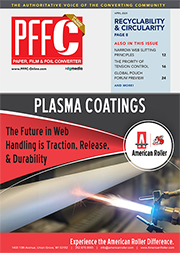Featured Stories
-
Innovation in Extrusion Barriers Can Reduce Brand Owners’ Dependence on Plastic
According to the most recent statistics from the Environmental Protection Agency1, in 2018 the U.S. produced 35 million tons of plastics, while... -
Tension: The First Thing We Must Get Right
Web tension is arguably the most important parameter for any web process. Tension is the first thing we must get right. -
Principles of Narrow Web Slitting
For those veterans in the slitting-winding community, this commentary is not necessarily new information, but reviews are always good too.
News | New Products
-
TIPA Compostable Packaging Appoints John Wilson as Commercial Director for North America
Packaging and sustainability industry veteran joins TIPA, to drive US adoption of compostable packaging to curb plastic waste
-
INX promotes three to Vice President positions
The Board of Directors at INX International Ink Co. have approved the promotions of three key executive managers to vice president positions.
-
Rogelio Barba Villagran Named Business Development Director for AGH Labels North America
AGH Labels, headquartered in Leon, Mexico, is excited to announce long-time executive, Rogelio Barba Villagran, as its business development director for AGH Labels North America.
-
Hong Kong PrintPack Fairs Open in April
Jointly organized by the Hong Kong Trade Development Council and CIEC Exhibition Company (HK) Limited, the two PrintPack Fairs will be April 27-30, 2024 at AsiaWorld-Expo
-
BioEmitter®- Keeping Corrosion and Rust at Bay in Enclosed Spaces
One of the most important missions of Cortec® Corporation, a global leader in the corrosion protection industry, is environmental responsibility.
-
Fedrigoni Names New Commercial Senior Vice President, Chief Marketing Officer
Fedrigoni — the world’s leading manufacturer of specialty papers, premium self-adhesive materials, RFID and connected solutions
-
SEI integrates Vetaphone on new Labelmaster KyoJet
SEI Laser Converting is based in Buja in the northeast corner of Italy.
Expert Advice
Meeting the Sustainability Challenge Without Compromising Barrier Performance
- Published: January 29, 2009
It is clear by now that retailers are the main drivers of the sustainable packaging movement, and they have put their money where their mouths are. Wal-Mart, Tesco, and many others have developed comprehensive sustainability programs, including sophisticated measurement tools and hard targets.
The second thing that has become clear is that economics drive sustainability, not vice-versa. Sustainability programs have come to encompass sustaining the economics of the packaging as well as sustaining the environment, which means the most successful offerings will improve the bottom line as well. Consumers and governments continue to apply pressure as well, as they become increasingly green conscious and energy policy has become a major political issue.
The converting industry and CPGs [consumer packaged goods companies] are critical to sustainability’s success, and they have both stepped up to develop sustainable solutions for retailers. The movement has high visibility at trade shows, sustainability-related symposia and conferences, and industry sustainability groups. Several sustainability solutions applicable to barrier films have been investigated.
Biodegradable Films
The most commercially advanced and available biodegradable, renewable resource-based film on the market continues to be PLA [polylactic acid]. It has good clarity, sealability, and deadfold, and all commercially available films meet the ASTM D6400 compostability requirements. This film’s main drawbacks are its poor temperature resistance and poor barrier properties.
Two possible solutions to the barrier issue are to apply an SiOx clear barrier layer or a metallized barrier layer to the PLA film. Neither of these inorganic nanolayers negatively impact the compostability of the base PLA film. Furthermore, the improvements in barrier properties achievable with these layers are virtually independent of the thickness of the base film.
We have measured metallized and SiOx-coated barrier properties on several different gauges of PLA film from several different film suppliers. We have chosen to focus on
80 g, which is the thinnest PLA film that is widely available.
The improvement in barrier properties can be seen in the barrier maps in Figures 1 and 2 and the graphic in Figure 3. The barrier maps compare the barrier properties of the plain 80-g PLA film to the SiOx-coated or metallized PLA, and then the coated PLA laminated to another 80-g PLA layer. These properties are overlayed on a barrier map showing the barrier requirements of typical food packaging applications.
We have shown that it is now possible to achieve truly high barrier all-PLA package with a two-ply structure of reverse-printed Ceramis PLA laminated to a metallized Enviromet PLA.
Accompanying figures:
Figure 1: Ceramis PLA Barrier Properties
Figure 2: Enviromet PLA Barrier Properties
Figure 3: Ceramis PLA in the Real World – a One Week MAP Shelf Life Study
Source Reduction
We have already mentioned that packaging economics are the largest driver of sustainability. However, retailers generally are not willing to sacrifice performance for improved economics. Today it is possible to marry cost savings and sustainability together using three different approaches to source reduction, which reduce costs without compromising the barrier performance of metallized films:
- Downgauging
- Less aluminum
- Layer elimination
In the first case, the vast majority of barrier food packaging applications in North America continue to utilize 48-g PET. It is the most readily available and one of the most cost-effective gauges on the market. Recently, several PET suppliers have been developing their thinner-gauge PET films. Greater effort has been put into metallizing these films in a high quality, reproducible, cost-effective manner.
As with PLA film, the barrier properties of the metallized PET films are practically independent of the base film gauge. This is proven in Figure 4, which shows oxygen transmission rate (OTR) and water vapor transmission rate [WVTR] values of three different polyethylene terephthalate (PET) gauges, all metallized on the non-treated side under similar metallizing conditions and at a 2.3 target optical density (OD). Error bars represent 95% confidence intervals based on several measurements on each base PET gauge. OTR measurements were carried out at 73.4°F and 50% RH. WVTR measurements were carried out at 100°F and 90% RH. All testing was carried out on unlaminated films.
Figure 4: Impact of PET Downgauging on Barrier Properties
Systematic investigation has been made into applying less aluminum, lowering the OD of the metallized layer, without compromising barrier properties. This is possible, as long as the quality of the metal layer is significantly improved.
In addition to OD, the density, level of pinholes, and adhesion to the substrate all play critical roles in determining the barrier properties of a metallized film. Figure 5 shows the oxygen and water vapor barrier properties of two different sets of metallized PET films, measured under the same OTR and WVTR conditions reported earlier. One set was run under standard metallizing conditions, to a 2.3 OD target. The other set was run on the same metallizing equipment, using the same set of base films, but run to a 2.0 OD target using a proprietary “High Efficiency” metallizing process.
Less aluminum not only leads to source reduction but also means less energy is used in the metallizing process to heat boats, drive stepper motors, etc.
Figure 5: Proprietary High-Efficiency Metallizing Process at 2.0 OD
The last form of source reduction examined is layer elimination. More specifically, the combining of two separate layers, the barrier and the sealant web, into a single “barrier sealant” layer. This can be used to replace metallized PET in the case of high oxygen barrier applications, or to replace metallized oriented polypropylene (OPP) or foil in the case of high moisture barrier applications. Table I exhibits the various layer elimination opportunities available. Table II shows barrier and sealant properties achievable in a single-ply structure.
Tables I and II: Layer Elimination Opportunities Using Metallized Sealants and Measured Barrier & Sealant Properties
Note that these barrier numbers are only achievable with a high barrier metallizing process. These metal adhesion numbers are only achievable with an adhesion-promoting surface on the metallizable side of the sealant web. Standard sealant webs metallized under standard metallizing conditions will not perform to the specifications outlined above.
Figure 6: The Savings Opportunity From Barrier Sealants
Figure 6 shows a typical costing model for a Barrier Sealant product. It allows the converter to eliminate the second lamination pass, providing a more cost-effective solution to the end-user. Furthermore, the converter no longer has to stock two separate films when a single film will do.
Conclusions
In barrier packaging, there are many opportunities to improve packaging economics while becoming more sustainable. Converters need to make a conscious decision to innovate and work with customers and suppliers to achieve their sustainability goals. When they do, they will find there are several ways in which demanding barrier properties can be achieved in a more sustainable manner. This benefits the bottom line as well as the environment and will continue to help make flexible packaging the sustainable choice for CPGs and retailers around the world.
Supplier Information:
Celplast Metallized Products Ltd. | www.celplast.com













